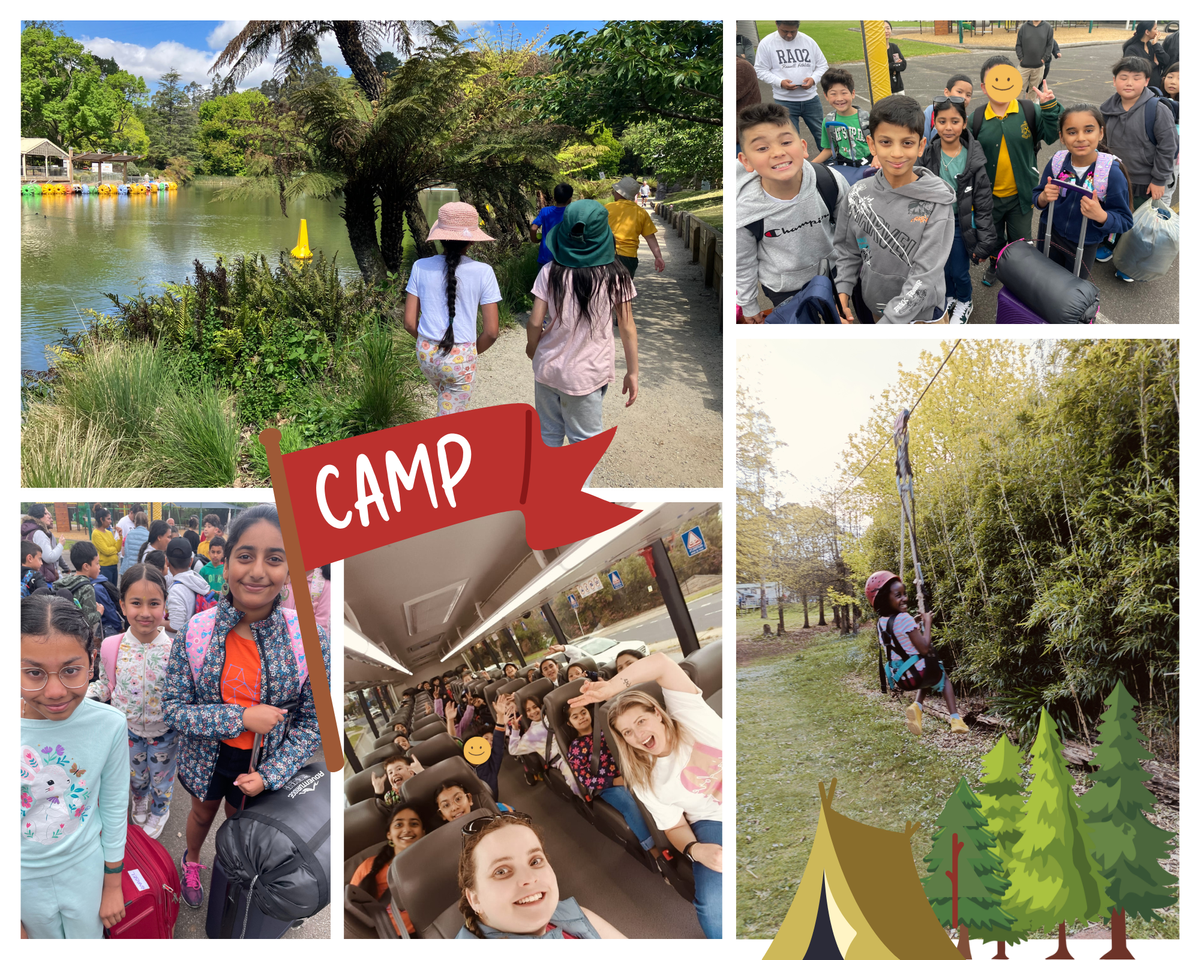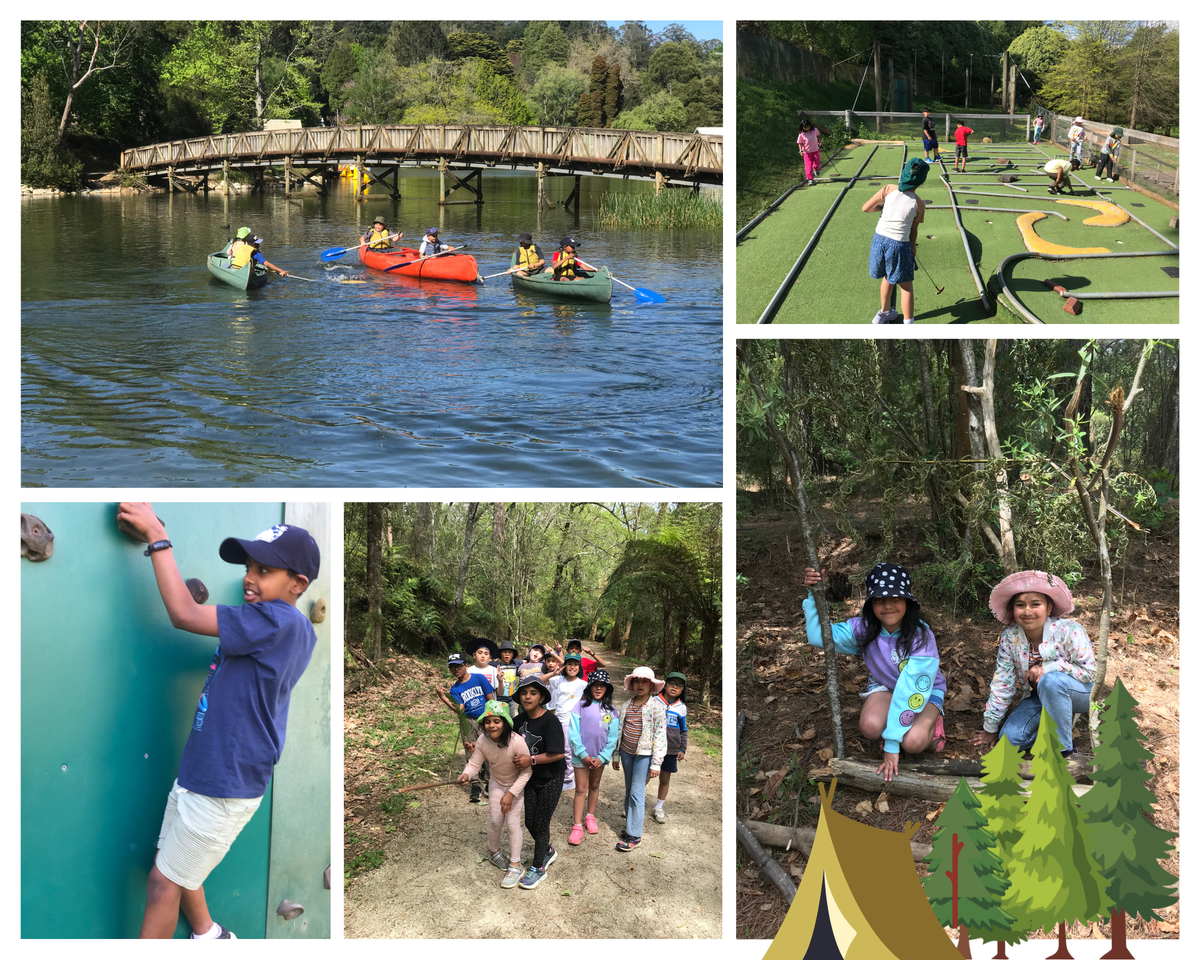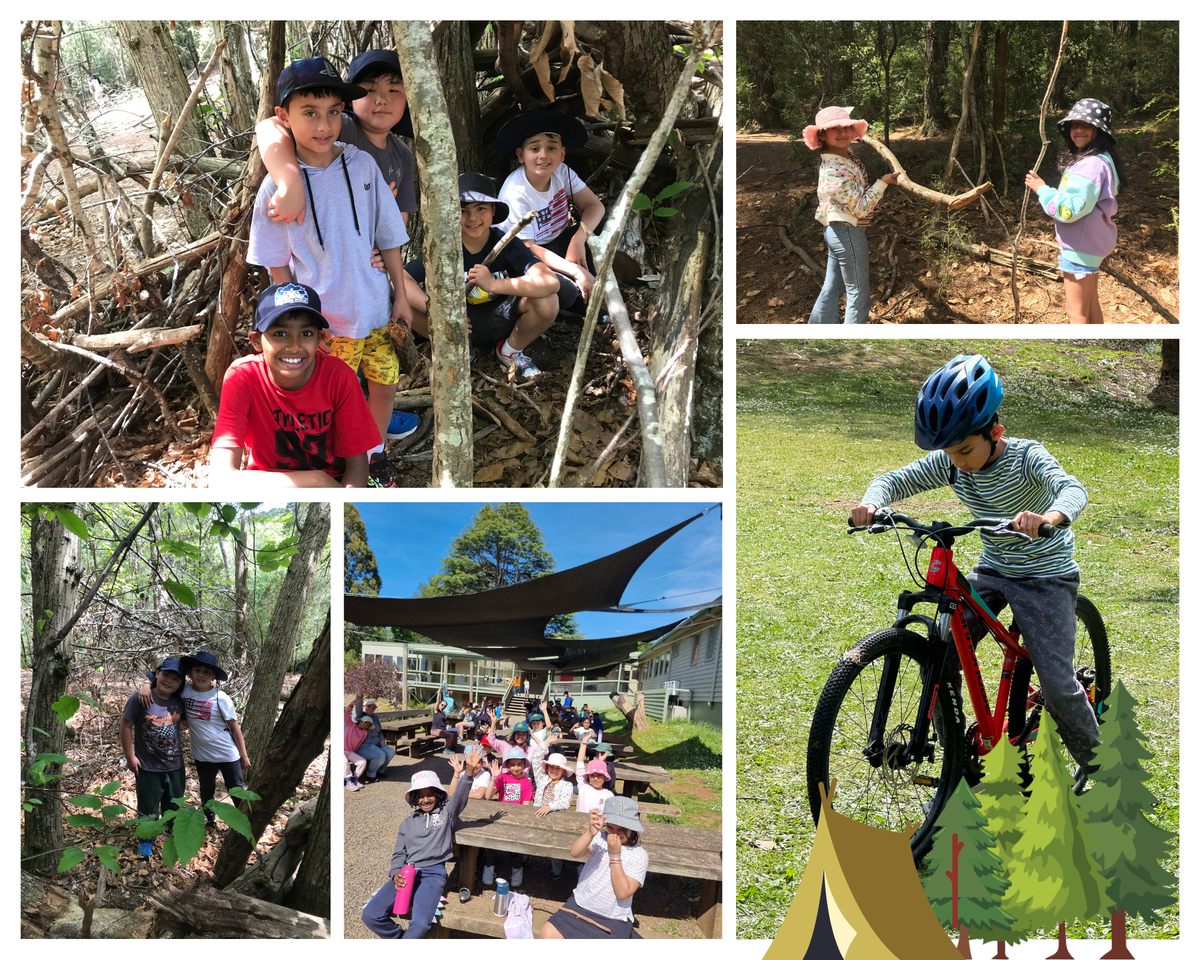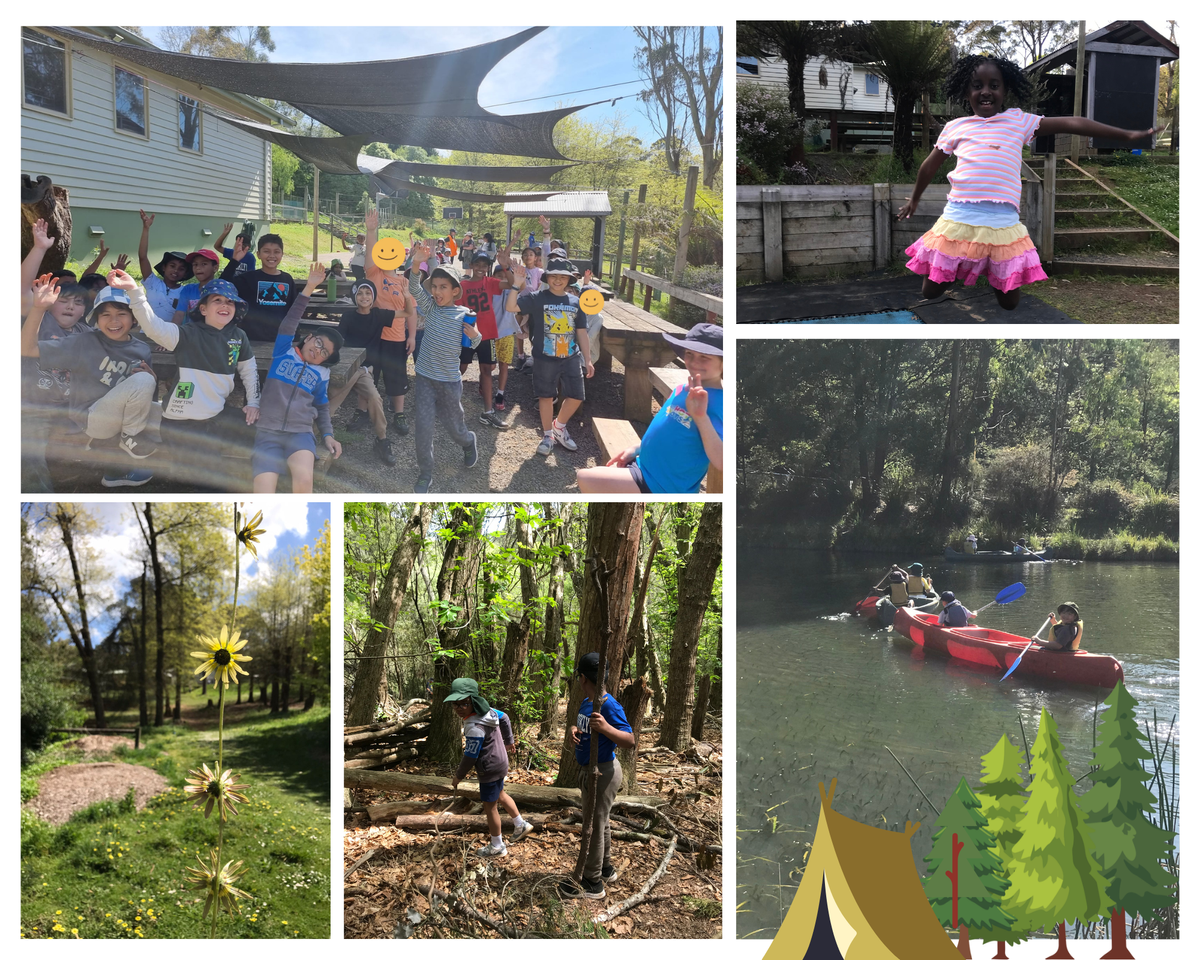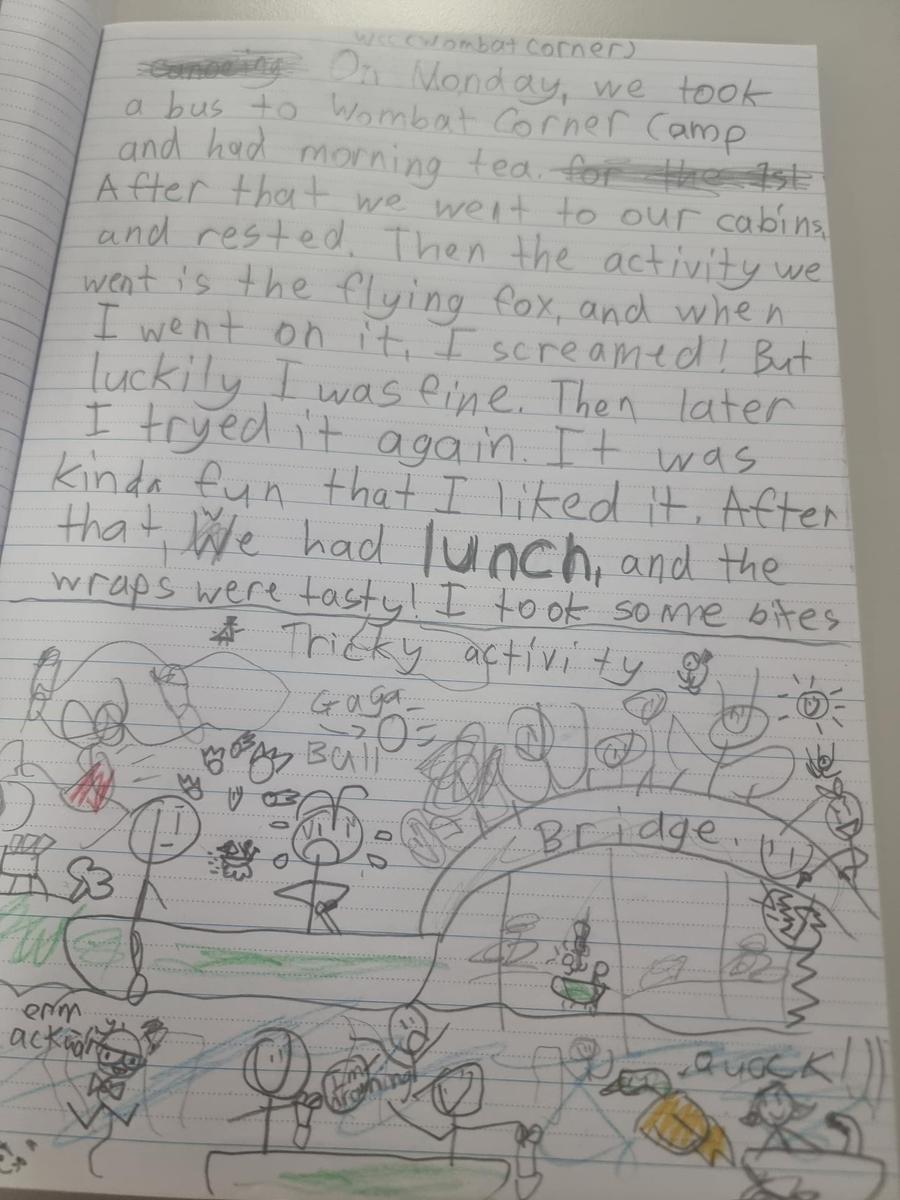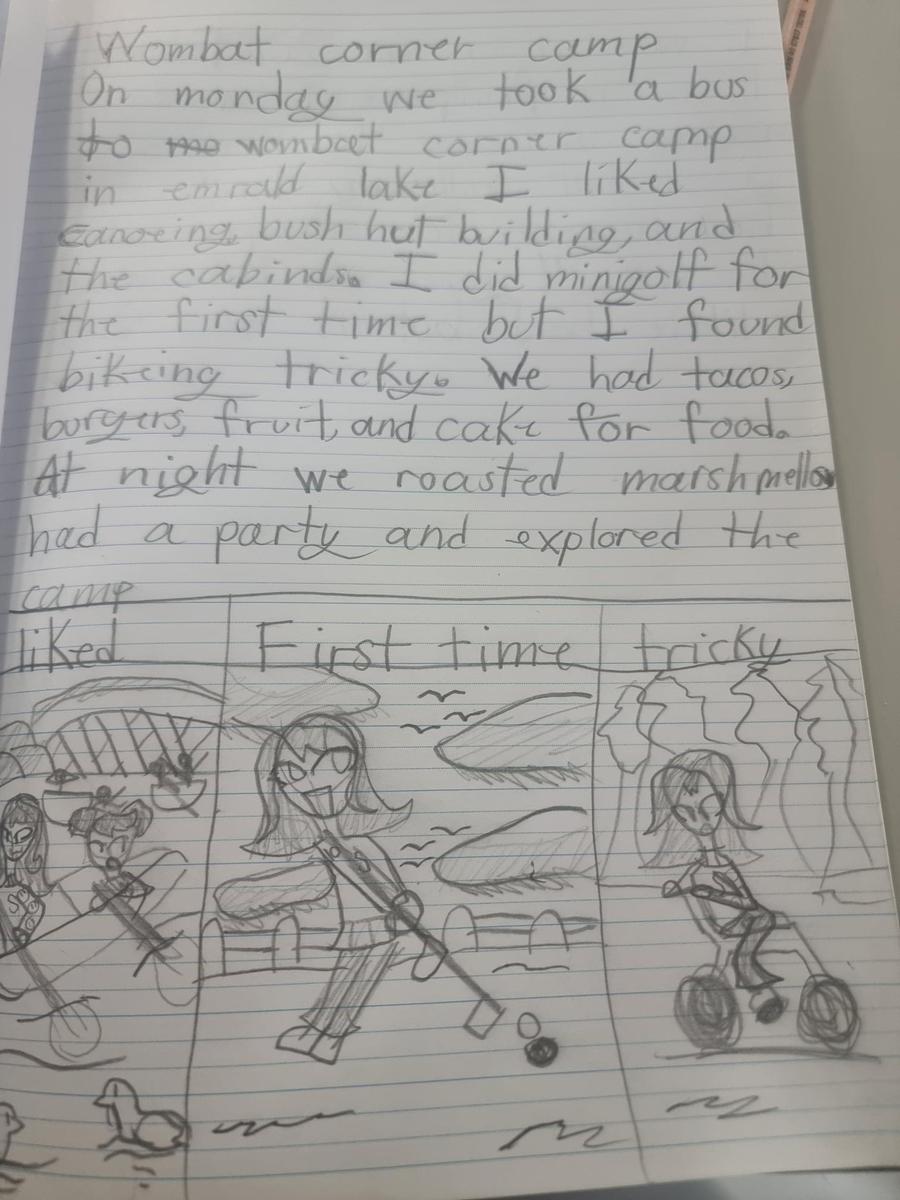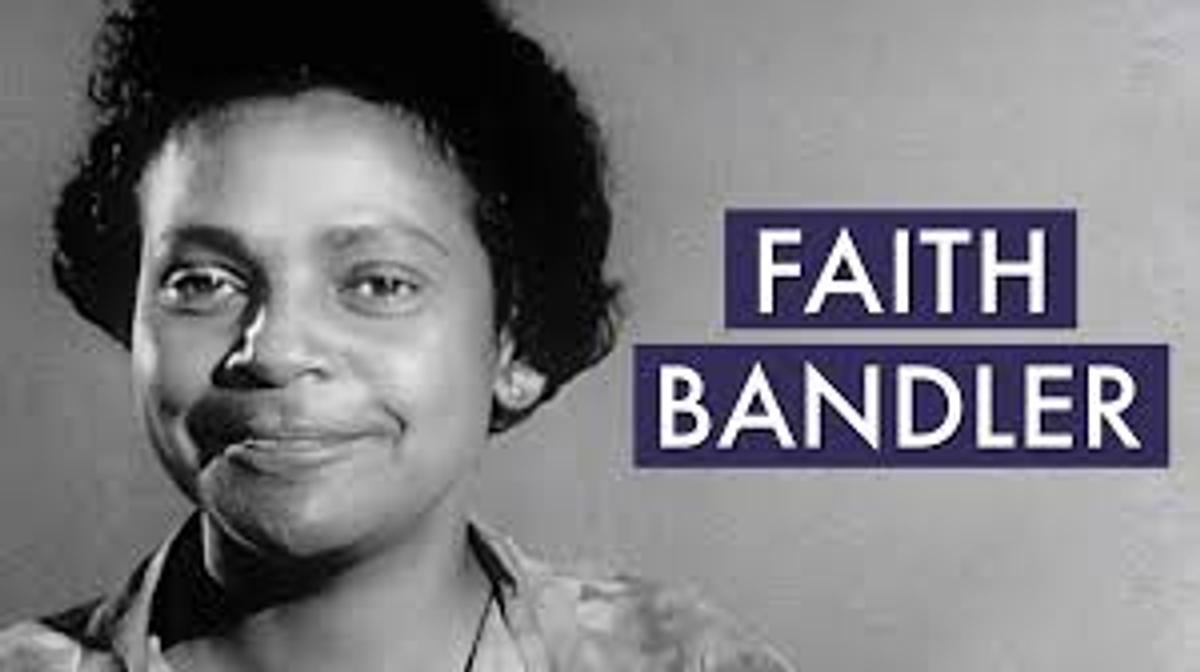Celebrating our Learning
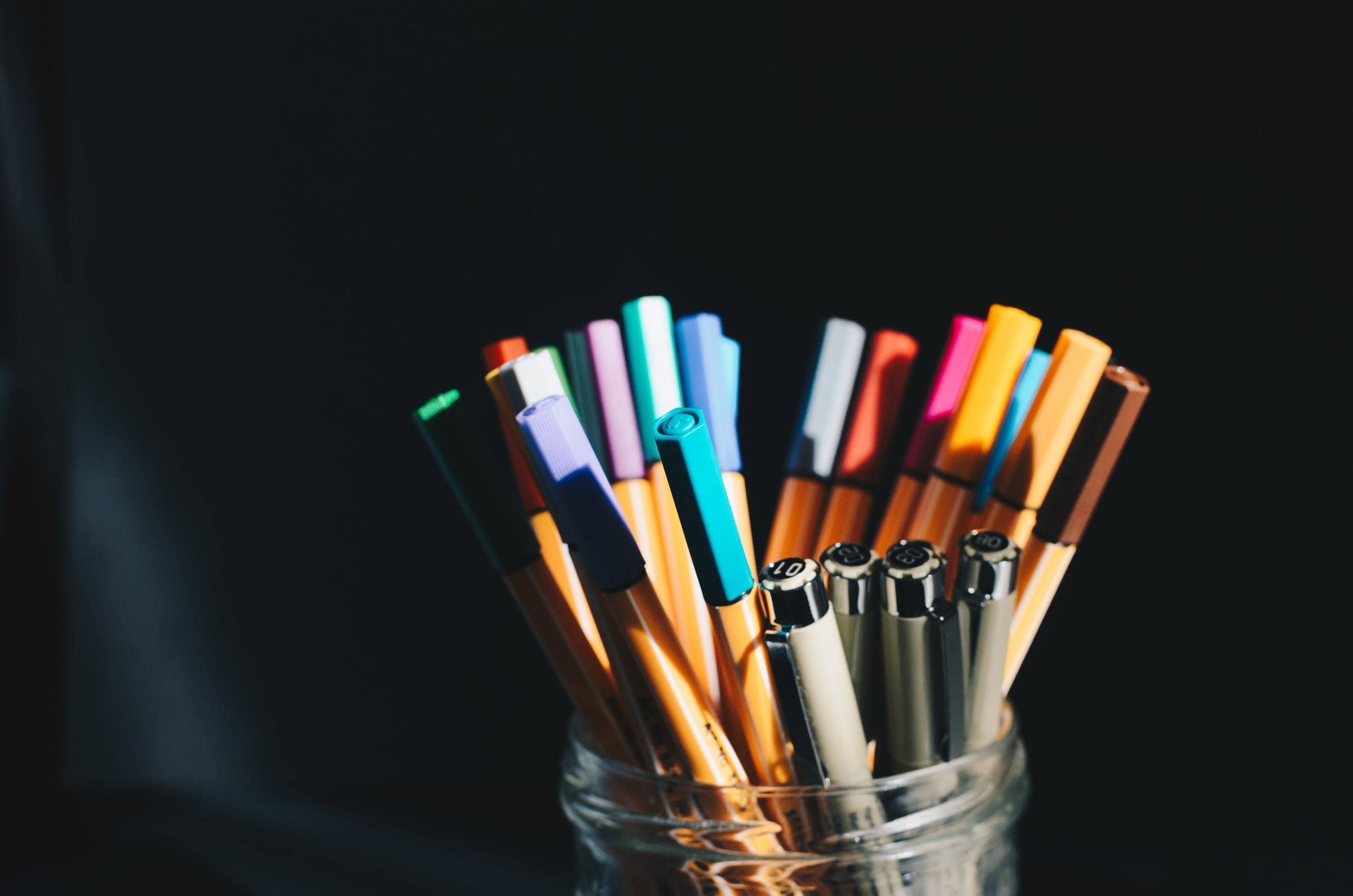
Wombat Corner Camp - Year 3/4
Last week, the Grade 3/4s had the privilege of attending Wombat Corner Camp in Emerald for a one-night, two-day adventure! Read below to hear from some of the students about the wonderful activities, meals, and experiences they had.
3/4 Camp
On the day we went to camp, we said goodbye to my parents. We took a bus. It was a 45-minute drive, and I sat next to Ethan. When we arrived, we had morning tea; then we looked at our cabins. I was sleeping with Aleena, Betty, Rohitha, and Namasvi. Then, I did my first activity. It was a flying fox, and they showed us how to put something on so we were safe. I had to wait until it was my turn. I got help from Namasvi because I didn't know how to put it on. Then I went. It was like a swing high in the sky where the trees were. Miss Rumble was at the bottom, so we were safe. It was really fun, but I didn't like going up. I did it once; then I had lunch. It was a wrap. I got to put anything I liked in it. Then, I went canoeing and partnered up with Namasvi. I got all wet at the end, then I took a shower and changed my clothes. I organised my cabin; then I did my next activity. It was bush hut building. Our base was the best; we had to make it with things from the forest. I was making the campfire. I had afternoon tea, where I had an orange with some biscuits. Then we had free time and went to our cabins. Afterwards, we had dinner and ice cream. I had two ice creams, a potato, sausage with tomato sauce, and a sandwich. At night, we had a night walk and ate marshmallows. We went to the games room, and I wore my pyjamas, then we had a dance party. After, I sat near the campfire and heard a story. Then I did some drawing and went to sleep. When I woke up, I changed my clothes and had free time. We ate breakfast, and I had cereal with juice. Our activity was mini golf/low ropes, and then I had free time. I went on the trampolines and then had lunch. I had oranges, crackers, and cheese. We then had free time and packed our bags. Finally, we went on the bus, and I sat with Lianne. Then we arrived, saw our families, and went home.
By Emily G (Gr 3)
3/4 Camp!
On the first day of camp, we went to Wombat Corner Camp. I had my morning tea, eating an apple, mandarin, and crisps. My morning tea was really yummy. After morning tea, it was time to go to our cabins. I had Dylan, George, Russel, Johaan, Andres, Somiithran, and me. We were unpacking in our cabins. I took the top bunk next to my best friend, Dylan. I had no one under me. We had activities. I had mountain biking first. I fell into a bush with sticks and got hurt and scratched a lot. We went on a steep hill and went as fast as light. It was so fun!!!!!! After that, it was lunch at 12:30. They made really good food with wraps. It was like a five-star restaurant. I don't know how they cook so well. After lunch, my group had flying fox. It was so fun!!! I went so fast I felt like I was The Flash, running at a speed of 1000mps. It was the best ever!!!! Right after flying fox, we did low ropes and mini golf. Personally, I liked mini golf better than low ropes. For dinner, we had meat patties or sausages. I chose sausages, and there were also wedges. I had the wedges with tomato sauce, and it was so good!!! After dinner, it was bedtime. We all went to bed at 9:30, but I went to bed at twelve o'clock and woke up at 4:00 in the morning. When we packed at 4:00, I packed my sleeping bag and clothes, getting ready for our next activity, canoeing. After everyone was done packing, we ate breakfast. We had scrambled eggs, hash browns, cereal, and toast. I had scrambled eggs. They were so good! After breakfast, it was canoeing time. I loved canoeing. We went to a lake where there was a bridge on top of us. We had to chase the teacher, Matt. My friend and I almost got Matt, but he was going so fast that no one got him. After finishing canoeing, we did bush hut building, and we found one that was almost finished, so my group and I finished the hut. I went deeper into the woods to look for humongous sticks. I found a huge stick that needed thirty kids to hold. It was like a whole tree on the ground. When we got back from bush hut building, the bus was there, so everybody started getting ready for the long ride back to school. When we got to school, the teacher allowed us to play on the playground. On the playground, we played off-ground tiggy. I was super fast on the monkey bars because I didn't want to get tagged.
By Andreas P (Gr 4)
3/4 Camp at Camp Wombat
On Monday the 14th to the 15th, we had camp. First, we gave our luggage to the bus driver to put in the compartment on the side of the bus. Next, we got on the bus, and I sat next to Janvi and read my Harry Potter book. Most of the boys sat at the back of the bus. The drive to Emerald took one hour. After we got there, we grabbed our bags and brought them into the foyer. Then, we brought our bags into the dining room and ate our snacks. Then, we brought our luggage into our cabins, unpacked, and made our beds.In my cabin, I had Sanvi, Odeleyah, Cecilia, Gianna, Sky, and Riya. Sanvi, Odeleyah, and Cecilia and I had our own section in the cabin. Sanvi’s bunk was underneath mine, and Odeleyah’s bunk was underneath Cecilia’s. Then we went outside to get into our activity groups. The first thing my group did was bush hut building. The teacher for that activity was Matt. When we finished, I built a pretend campfire, and we added some thick logs so we could sit around the pretend campfire. When we finished, everyone went inside our hut, and everyone fit in, so we took a picture together. After bush hut building, we ate lunch. For lunch, we had wraps, and they were delicious. Next, my group went biking. There weren't any more small bikes, and I couldn't ride the big green bikes, so I went to watch the group that was ziplining. The next activity was canoeing. It was really fun, except for the part where I had to drag Zion and his canoe out of the reeds. I got really wet, so I took a shower, and then we had dinner. We had ice cream for dessert. After that, we had a campfire and a disco party and played in the games room. Then we changed into our pyjamas, brushed our teeth, and went to bed. After a while, everyone woke up, and we had a midnight feast. When everyone woke up, we started packing up our stuff. After packing, we had toast and cereal for breakfast. It was really good. Our next activity was flying fox. In the end, Sanvi and I were the only ones left, but it was still really fun because we got even more turns! Our last activity was low ropes and mini golf. I liked the low ropes because it was really challenging. The mini-golf was also really fun, and I got many scores. Next, we had lunch. For lunch, we had wraps again, but they were still really good. Finally, it was time to leave, so we grabbed our luggage and gave it to the bus driver. We arrived at school earlier than expected, so we had some time to play on the playground. Then, we went home after two adventurous days at Wombat Corner Camp.
By Adonia A (Gr 4)
Emily Rumble and Sonia Lopez
Year 3/4 Teachers
Biographies in Years 5/6
In the 5/6 level, we have been learning how to write an engaging biography. Students looked at the structure and features of a biography. They all learned about and researched Faith Bandler, an activist for the rights of First Nations people of Australia and the South Sea Islands. The students were encouraged to include more sophisticated vocabulary in their writing to engage their readers. We’ve included a few different biographies here for your reading pleasure!
Faith Bandler The Aboriginal and Islander Activist (Christopher Yr 6)
Faith Bandler is an Australian activist of Indian and South Sea Islander descent. Faith was a committed person who wanted recognition for the Aboriginal and Torres Strait Islander people to be seen as orderly civilians in the land of Australia. Her life was inspiring to many, along with the fact she was quite popular, as she had been involved in a peace movement and co-founded “Aboriginal-Australian Fellowship” with Pearl Gibbs, another equal rights activist. Her most popular act was her fundamental role in the ‘yes’ vote for the Australian 1967 referendum. Faith’s father Wacvie Peter Mussing was from Biap village, Ambrym where He was taken to Australia and forced against his will to work in sugarcane fields as a slave in 1883, while he was only 12 years old. Her mother, Ida Venno was of Scottish-Indian descent born in Brisbane.
Faith’s Early Life
Faith was born on the 27th of September 1918; in her early life, she was raised in the minute community of Tumbulgum, North of NSW, and later on, she transitioned to Murwillumbah, where she went to Secondary School. Faith’s education was pursued at Murwillumbah Secondary School after passing the entrance exam. The yard was a hot spot for discrimination and controversies. The teachers and adults surrounding her were constantly protecting Faith from racist, rude and vulgar kids, but at home, things were worse. Her financial life was struggling, especially because of the fact that her father had died when she was 5 years old, alongside the fact that her family was of 8 children, but this didn’t bother her. Faith even quotes: “We didn't think we were poor because there was very little competition. Everyone was poor.” Later on, in 1934, she moved to Sydney and worked for a while as a dressmaker's apprentice.
Faith’s Adult Life
Her adult life consisted of acts that varied from grand and honourable to just average things that any other adult would do. Faith wasn’t a superhero; she was a normal person who saw the discrimination within her community and wanted a change. During WWII, she and her sister, Kath, served in the Australian Women’s Land Army. Discrimination occurred here, too. Faith and her sister, alongside other Indigenous workers, had received less pay than white workers for doing the same work. After the war, Faith moved to the Sydney suburb of Kings Cross, NSW, where she worked as an abuse activist. In 1952, Faith ended up marrying a man named Hans Bandler, who was a Jewish refugee from Vienna that managed to hold an escapade from the Nazis. In the late 1950s, she became a full-time activist, co-founding the Indigenous rights organisation Aboriginal-Australian Fellowship with another Australian activist, Pearl Gibbs; this was her most popular act. Several massive petitions and many public meetings arranged by Bandler resulted in the 1967 referendum being put to the people by the Holt government. This referendum or vote was one of the most successful votes in Australia's history, with 91 percent of people across Australia voting for the “yes” side of the vote.
Faith’s life has been inspirational and very virtuous due to her selfless acts for the Indigenous community; unfortunately, she has been deceased since the 13th of February 2015. Her life has left a big scar, and at that, a good one, on the Australian community. Rest In Peace, Faith Bandler.
FAITH BANDLER (Alanna P Yr 6)
Faith Bandler, a well venerated Australian leading campaigner who engaged in the concept of publicising the “yes” vote during the referendum in 1967. The referendum within 1967, regarded the issue of Constitutional intolerance, directly aimed towards the Indigenous people. Her father’s traumatising former involvement in the act of “blackbirding”, a practice in which conducted inexpensive exertion in order to help the institution of the Australian sugar industry, was a part of the reason why she became an activist. Additionally, aware of her father’s former involvement in being enslaved, Bandler began her profession as a civil rights activist, in which she devoted to representing the Aboriginal, Torres Strait Islanders, and South Sea Islanders people.
FAMILY BACKGROUND -
Bandler was born on the 27th of September, 1918, in Tumbulgum. She was the second eldest out of her eight siblings. Her father, Peter Musing was a South Sea Islander from Ambrym Island, who was brought to Queensland in order to work as an unpaid labourer, serving one of more than 60,000 South Sea Islanders who aided the institution of the Australian sugar industry. Her mother, Ida Lessing was an Australian-born of Scottish and Indian descent who was the person who instilled the vital concept of education and respect towards others. Faith was struck with the grief of her father at the young age of 5, when he unfortunately departed their family by passing away in 1923.
EDUCATION /EARLY LIFE -
Faith Bandler’s early childhood was additionally filled with misfortune, given that she was often faced with discrimination from the students that attended her high school at Murwillumbah. Despite acquiring the protection and nurturing from her teachers, she was constantly being harassed and racially abused. After The Depression, a severe international economic shortage that affected many countries across the globe eventually led to her schooling being cut short. Correspondingly, this resulted in Faith leaving her home town to head to Sydney, where she worked as a dressmaker’s apprentice in 1934.
CAREER/ACHIEVEMENTS -
In 1963, Faith Bandler was recruited as the New South Wales state secretary of the Federal Council for Aboriginal Advancement in which she represented the desires of the Aboriginal people from New South Wales. By playing the vital role as an Australian civil rights activist, she was later granted the award of National Living Treasure, a status in which was received by 100 people from the majority of votes who was known to have displayed prominent contributions to the Australian community.
Towards the time span of Elsa Ruseel painting the portrait, Faith Bandler co-founded the Aboriginal - Australian Fellowship along with the Aboriginal activist Pearl Gibbs. In 1957 the Fellowship launched the campaign for a referendum on Aboriginal citizenship rights, further demonstrating her success as a campaigner.
The widely admired campaigner unfortunately passed away on the 13th of February, 2015 at the age of 96 years old, establishing herself in Sydney, Australia. To this day she is still honoured for her duties and contribution to the profuse issue of discrimination towards the First Nations and islanders people, further acknowledged as the one person who said that 'an aboriginal can't get a house because he can't get a job.’
Faith Bandler (Eleesh Yr 6)
Faith Bandler is a well-known Australian activist who supports equal rights. She was a big icon in Australian history because she brought equality to Australians and Aboriginals. Her father Peter Mussing went missing. Her mother was Ida Veneno. She grew up on a farm in New South Wales and she died on 13 February 2015. Faith Bandler is a famous icon in Australian history.
Faith Bandler was born on 27 sep 1918 in the town of Tumbulgum. She had 8 family members and she lived on a farm. Over the years Faith has continued to remind Australians of the existence of Aboriginals of the 1967 Referendum achievement, both for Indigenous Australians and for the whole nation . For her, the Referendum campaign was a turning point.
Faith Bandler was an iconic part of Australian history because she supported equal rights for Aboriginals, Torres Strait Islanders and South Sea Islanders.
Faith Bandler (Rakshana Yr 5)
Faith Bandler was an Australian activist who advocated for equal rights to Aboriginals, Torres Strait Islander and South Sea Islander peoples. Faith Bandler was born in 1918 in Tumbulgum, NSW. Faith's dad, Peter Mussing, was a South Sea Islander; meanwhile, her mother, Ida Venno, was an Australian of Indian and Irish descent. Faith Bandler was an inspirational person and is well known for what she has done.
Early life
Faith was 1 of 8 children who was raised in a small town called Tumbulgum, when she later moved to another place nearby, Murwillumba. She moved to Murwillumba during her highschool years. When her father was 13, he was kidnapped, brought to Australia and forced to work in the sugarcane fields in Queensland. Faith's dad sadly passed away when she was only 5.
Education
When Faith Bandler went to high school, she experienced bullying consisting of harassment and racial abuse. Yes, she was abused and faced discrimination, but the kind and nurturing teachers supported her. The schools she went to were Murwillumbah and Cleveland Street Night School in Sydney. After what happened to her father, faith decided to do something about Aboriginal rights.
Career
Faith Bandler served in WW2 as a part of the women's land army (1942–1945). That's what she did until the 1967 Australian referendum. She said yes and wanted others to say the same thing too, so that is why she co founded the Aboriginal Australian Fellowship. She made people vote an immense amount of YES at an amount of 91%! It was the most successful referendum that Australia ever had! (at the time).
Key Achievements
In 1970-1972, she became NSW state secretary, in 1997, she was awarded a human rights medal, in 2000, Nelson Mandela awarded Faith with a ‘Meritorious Award in Honour and Gratitude for a life of courageous advocacy for justice and for Indigenous people, for human rights, for love and reconciliation’. And in 2009, she received the Order of Australia for advancing human rights and social justice, and raising public awareness and understanding of the heritage of South Sea Islanders and women’s issues.
Faith Bandler sadly passed away on the 13th of February in 2015. Her legacy still carries on as she still inspires people to this day. She will never be forgotten. Rest in peace, Faith Bandler.
Faith Bandler (Marcus Yr 5)
Background
Faith Bandler was born in a small community in Tumbulgum in northern New South Wales. Her dad was kidnapped at the age of 13 her dad’s name was Peter Wacvice Mussing he got kidnapped from the island Vanuatu and he was forced to do work in sugar plantations in Queensland, Australia. Her mother was named Ida Venno and she was an Australian born and she is also Scottish Indian.
Childhood/early life
Faith was born in 1918 she was raised in a small community in Tumbulgum northern New South Wales and then she moved to Murwillumbah and then went to high school.Her childhood was not that good but she was a child out of 7 children she was also racial abused really bad.
Education
The high school Faith Bandler went to was Murwillumbah High and the night school she went to was at Cleveland street in Sydney. When she reached high school she was not treated nicely and fairly by the students because of her skin colour and so the teachers tried their hardest to take care of Faith.
Career
In 1963 Faith Bandler became the New South Wales state secretary of the federal council for Aboriginal Advancement. She was also a civil right activist for Aboriginal and Torres Strait Islanders. Faith Bandler was really important to the Aboriginal and Torres Strait Islanders and Australians because she campaigned and it took 10 years for equal rights and that aboriginal Australia would be treated the same way.
Faith Bandler was really important because she was an civil rights activist for Aboriginal and Torres strait islander Faith Bandler she was important because she won the equal rights for the aboriginal and Torres Strait Islanders.
Faith Bandler (Daniel B Yr 5)
Faith Bandler was an inspiring Australian activist and writer who supported the equal rights of the Aboriginal, Torres Strait Islanders and South Sea Islanders. Faith’s families were South sea islanders. Faith was known for becoming a New South Wales State Secretary of the Federal Council for Aboriginal Advancement, and started becoming more known once she started publicicing the ‘yes’ case for the Aboriginal question in the 1967 referendum.
Early life/ early career
During life as a kid, Faith was born in Tumbulgum New South Wales in 1918 an Indian/Scottish/Australia and was raised near a farm in Murwillumbah Faith was also one of eight children. Faith's father died when she was 5. She attended school in Murwillumbah and then went to Cleveland Night School.She only experienced harassment and racial abuse and discrimination by her classmates. Later Faith left school in 1934 then left for Sydney. After Japanese submarines attacked Sydney Harbour in 1942 Faith joined the women's land army with her sister but still experienced racism. She and her sister were paid less than other white women for doing the same work. After working three years in the land army Faith was disappointed because the army did not acknowledge the land army girls. The NFAS interviewed her about her life in 1993 saying herself” One thing that was sad was the land army girls were a part in the war but there was no acknowledgement afterwards and weren't considered a force, they merely filled in while the men were away, when the men came back for their job's the women were forced to find something else”.
Late life/late career
After the war Faith went back to Sydney and got a job at a shirt factory, later Faith married Hans Bandler in 1952 a Jewish refugee from Vienna that escaped the Nazis. Two years after marrying Faith a had a daughter named Lilon Bandler. Soon Faith became a full time activist and co-founded the Aboriginal Australian fellowship in 1956 along with Pearl Gibbs, Bert, Groves and Grace Bardsley. Then 1963 Faith Bandler became the New South Wales secretary of the Federal Council of aboriginal advancement. With all of these important roles Faith Bandler and her mentors, Pearl Gibbs and Jessie Street, started a campaign which Faith led for a Constitution referendum. A Constitution referendum is a national vote to change the Constitution based on a question, after many meetings and huge petitions is the now famous 1967 referendum the question was "An act to alter the Constitution so as to omit certain words relating to the Aboriginal race in any state and so that the aboriginals are to be counted in reckoning the population”? This question ended with an astonishing 91% ‘Yes’ vote across all states. Because of this Yes vote referendum led to a change to the laws and let Indigenous people have equal rights. After the referendum Faith was awarded a MBE in 1976 and a honorary doctorate from Macquarie University in 1994.Even after referendum Faith still did events and campaigns for various different things.
Family information
Father: Peter Mussing born in 1871 was a South Sea islander and raised in Biap village Ambrym,Peter got bought for 7 too 24 dollars when he was 12 and was brought to Queensland to work on sugar plantations which is called blackbirding. This is when people are forced as unpaid Labor which is slavery and had to do this Labor with around 60,000 other South sea islanders but later escaped in 1871 with other South sea islanders and later married Ida Venno. Peter died in 1924 when Faith was only 5.
Mother: Ida Venno, Ida venno is Australia born but is a Scottish/Indian descent and taught Faith many things in Faith's early life like importance of education and self respect and how to dress.
In February the 13th 2015 Faith Bandler died age 96 in a nursing home Faith Bandler died as an inspirational activist/writer helping the lives of many Aboriginal and Torres Strait Islander people. Her inspiring act of courage to stand up for the less fortunate Indigenous people left a mark in history and she is now a hero for the First Nations people of Australia.
Biography of Faith Bandler (Annie Yr 6)
“If not now, when? If not us, who?” -Faith Bandler
Introduction:
Ida Lessing Faith Mussing (27th September 1918 - 13th February 2015) was an Indigenous rights activist, most famous for making a monumental impact on the 1967 referendum. She was better known as Faith Bandler by the public, and mainly advocated for equal pay and rights for Indigenous and South Sea Islanders. Faith was also known for campaigning for removal of offensive language directed towards Aboriginal people in the National Census of Australia.
Family Background/Early Life:
Ida Venno was Faith’s mother, and she was a Scottish-Indian woman born in Australia, while her father’s name was Wacvie Mussingkon (later known as Peter Mussing). He was enslaved and taken from Vanuatu to work in a sugarcane farm in Queensland when he was 13, in a process known as “blackbirding”1. She was the sixth of 8 children and was always called Faith, even though her given name was Ida. Faith’s parents married after her father crossed the border and married Ida to exempt the Pacific Islander Labourers Act in 1897 2. Peter Mussing died in 1924, when Faith was only 5. Faith married a Jewish refugee (Hans Bandler) in 1952, and two years later they had a daughter named Lilon Bandler.
Education:
Faith attended high school in Northern Murwillumbah, NSW, where bullying and harassment was a common occurrence. Though the teachers there were compassionate and protected her from any harm she may have encountered during her time there. She was incredibly strong facing all the racist comments directed towards her, and this experience led her on to fight for her and others rights.
Career:
During World War 2, she joined the Australian Women’s Land Army to work in farms where she found that people of Indigenous or South Sea Islander descent were paid less. After the war she began working in a shirt factory, until in 1951 she joined the “Unity Dance Group” and performed all over Europe with a dance based on a poem. In 1956, Faith and Pearl Gibbs (an Aboriginal Rights Activist) both founded the “Aboriginal-Australian Fellowship”. For the next decade, they both campaigned to get the federal government to hold a referendum to discuss discrimination against First-Nations People. Finally, in 1967, the government succumbed to her wishes and won with a whopping 90.77%, giving Indigenous people the rights they deserved.
Achievements:
Faith Bandler has achieved many things in her life, but one of the most memorable was when she pushed for land rights for South Sea Islander peoples as well. Though Aboriginal and Torres Strait Islander Peoples had earned their rights, the South Sea Islanders were not included in this minority. Faith served in the Federal Council in the 1970’s, but left because people were questioning why she wasn’t an Aboriginal person and in the council.
In 1974, after going to Vanuatu and investigating what happened to her father’s relatives, Faith formed the Australian South Sea Islanders United Council to improve the rights and pay of the South Sea Islander community all over Australia. Their work paid off, as in 1992 the government was convinced to investigate the matter, and finally recognised South Sea Islander peoples as an ethnic group. In 1976 she was offered a place as an MBE (Member of the order of the British Empire) but refused. A few decades later, in 1997, she was awarded a Human Rights Medal and named a “National living treasure”.
Conclusion:
Faith Bandler lived an amazing life, going through all the ups and downs of many Indigenous/South Sea Islander peoples, and was resilient through it all. Unfortunately, Faith died at 96 in 2015, and died a peaceful death. Faith will always be remembered as one of the greatest Australian Human Rights Activists throughout history.
1 Blackbirding was a process used in the 19th and early 20th century to enslave South Sea Islanders, and kidnap them to work in Sugarcane/Cotton farms. 2 This act was passed to restrict South Sea Islander Peoples from entering Australia, and if they were already residing in Australia, they would be sent back to their home country. It was created in 1901 to get rid of all the Pacific Islanders currently in Australia (see above)
Monica Bowen and Bronwyn Chamberlain
Year 5/6 Teachers

